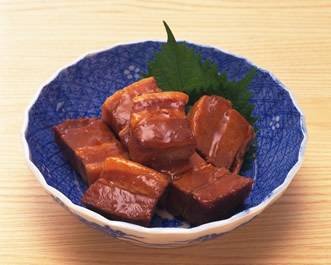Articles on Japan, Links & Reviews
Food in Japan
Buta-no-Kakuni
Buta-no-Kakuni is a small dish of braised cubes of pork-belly that is commonly seen on the Japanese dinner table as an accompaniment to rice or other dishes. Buta-no-kakuni is usually prepared well in advance and slow-cooked to create the melt-in-your-mouth texture it is famous for. And being packed full of collagen means it can be considered reasonably healthy, despite containing quite a lot of fat on the meat initially.
Having been simmered for a long time, the meat should take on the rich, sweet flavor of the broth leading to its distinctive flavor, although many Japanese will add a touch of spicy mustard for an even more exquisite taste. Simmering in sake instead of mirin is recommended to provide the most tender texture, so that the meat should literally fall apart if you squeeze too hard with your chopsticks.
The meat is the cut from around the ribs, basically a spare rib without the bone, so although it is quite a tough cut of meat, simmering it for over an hour will usually be enough to make it juicy and tender. In fact we recommend attending to some other household chores while letting the dish take care of itself. To obtain a more balanced intake of nutrients, we also recommend eating it with some lightly boiled vegetables such as chingensai (Shanghai cabbage), spinach or other greens.
The dish is reported to have been adapted from a similar Chinese dish, called tonporo in Japan, that was introduced through the port of Nagasaki during the isolation period. In most of Japan, Buta-no-Kakuni is the common name for this dish, although in Okinawa it is familiarly known as Rafte, while in Nagasaki it goes by the name of Toubani. The Okinawans, renowned for their longevity, believe that the high protein content found in the pork is a useful form of preventative medicine. They use pork belly in various dishes, such as ramen noodles, either with or without the bone attached.
Glossary
Chingensai
- Type of chinese cabbage, often referred to as Bok Choy, commonly grown in the Shanghai region
Ramen
- Long, thin, slightly yellow noodles made from flour, usually eaten in a hot broth flavored with a salt, pork, soy-sauce or miso base
Sake
- Japanese rice wine. ("Nihonshu" in Japanese)
Soy Sauce (Shoyu)
- A fermented sauce made from soybeans, roasted grain, water and salt.

Buta-no-Kakuni
Photo provided by FOODEX JAPAN
Buta-no-Kakuni Recipe
(Difficulty Rating: 2 out of 5)Ingredients (serves 4)
- 400g Pork Belly (Boneless pork rib meat)
- 100ml Sake
- 4 Tablespoons Sugar
- 60ml Soy-Sauce
- Water
Instructions
- Cut the pork into 5 cm cubes
- Fry the pork gently until all 6 sides are browned
- Place pork and plenty of water into large saucepan and bring to the boil
- After water has boiled simmer on low-medium heat for 45 ~ 60 mins
- Throw away the remaining liquid and gently rinse the pork
- Add pork and 3 cups of fresh water into the saucepan and bring to boil
- Stir in sake and sugar and simmer on low-medium heat for 15 minutes
(add water if it gets low) - On low heat, stir in the soy sauce, place a small lid (or kitchen paper) on the pork, and simmer for further 20 minutes
- Use strainer to remove any froth/scum from the surface at intervals
- Check taste regularly and top up with sake/soy-sauce as necessary
- After 20 mins, check meat is tender by running through with skewer
- Leave to cool, so that meat takes on flavor of sauce
- When ready to eat, bring to the boil for 1 minute and serve
- For any remaining broth, you can add radish or vegetables to make a mini stew-like side dish
In addition to Japan's Premier Shop Directory, English OK! offers the following services:
Customer Service English Training: Onsite Workshops, e-Learning & Books
Multilingual Website Design
